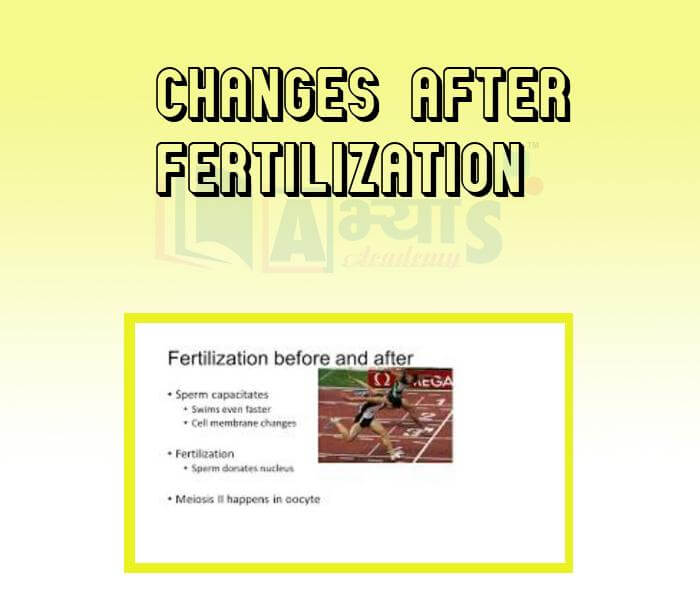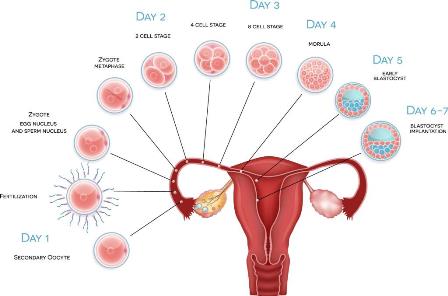Changes After Fertilization







Changes After Fertilization
Implantation: The fertilized egg (zygote) moves down the Fallopian tube and continuously undergoes cell division and forms 2, 6, 8 , 16 cells and so on. By the time it reaches the uterus it has already formed a small hollow ball of numerous cells (blastocyst). This is a kind of embryo which forms a pit in the wall of the uterus and gets fixed in it in about a week's time after ovulation. This is a kind The embryo gets embedded in the wall of the uterus, which is thick and has muscles, glands and a large number of blood capillaries. This process is called implantation.
Pregnancy: The developing embryo at first derives nourishment directly from the mother’s blood flowing in the vessels lining the uterine wall. In about three weeks, it starts absorbing food and oxygen through an organ called placenta. The placenta is a disc like organ in the lining of the uterine wall. It has numerous villi, which are in direct contact with the mother’s blood flowing in the uterine wall. These villi provide a large surface area for glucose and oxygen to pass from the mother to the embryo and for wastes produced by the embryo to be passed into the mother’s blood. The embryo is connected to the placenta by a tube called the umbilical cord. By the end of five weeks of pregnancy, the embryo is quite advanced. The heart and circulatory system have been formed. After two months limbs have also been formed. By eight weeks, the embryo starts showing human features and is referred to as foetus. The total period of embryonic development, from the time of fertilization to birth, is called gestation period. It is around 280 days, or 9 months, in humans.
Birth: The wall of the uterus develops a thick layer of muscles during pregnancy. At the time of birth, the uterine muscles contract rhythmically and powerfully, causing labour pains to the mother. At the time of birth, the baby is pushed out by powerful contractions.Finally, the baby is expelled by the contraction of the uterine muscles. This is called birth or parturition.
What happens when the egg is not fertilized: If the ovum is not fertilized in the upper part of the oviduct, it keeps on descending and is finally passed out through the vagina. It remains in the body for about 24 - 72 hours. As an egg is released for fertilization every month, the uterus also prepares itself every month for the implantation of a fertilized egg. The uterus becomes thick-walled and spongy in order to nourish the embryo. If no fertilization takes place, the thick uterine wall is no longer needed. So, it gradually begins to shrink. This shrinkage ruptures its blood vessels. As a result, blood and mucus ooze out of the vagina. This period, which lasts for 3—5 days, is called the menstrual period, and the process is called menstruation. If the ovum is fertilized, it gets implanted in the uterus wall and embryonic development starts. In this case, the uterus continues to develop in order to hold the embryo. And in this case, there is no question of its shrinkage resulting in menstruation.

Number of cells present in egg is __________________ | |||
| Right Option : A | |||
| View Explanation | |||
Connection between developing embryo and placenta is called ______________________ | |||
| Right Option : A | |||
| View Explanation | |||
Settling down of blastocyst on uterine wall is called ______________________ | |||
| Right Option : A | |||
| View Explanation | |||
Students / Parents Reviews [10]
Being a parent, I saw my daughter improvement in her studies by seeing a good result in all day to day compititive exam TMO, NSO, IEO etc and as well as studies. I have got a fruitful result from my daughter.

Prisha Gupta
8thOne of the best institutes to develope a child interest in studies.Provides SST and English knowledge also unlike other institutes. Teachers are co operative and friendly online tests andPPT develope practical knowledge also.

Aman Kumar Shrivastava
10thA marvelous experience with Abhyas. I am glad to share that my ward has achieved more than enough at the Ambala ABHYAS centre. Years have passed on and more and more he has gained. May the centre flourish and develop day by day by the grace of God.

Archit Segal
7thMy experience with Abhyas academy is very good. I did not think that my every subject coming here will be so strong. The main thing is that the online tests had made me learn here more things.

Hiya Gupta
8thIt was a good experience with Abhyas Academy. I even faced problems in starting but slowly and steadily overcomed. Especially reasoning classes helped me a lot.

Cheshta
10thI have spent a wonderful time in Abhyas academy. It has made my reasoning more apt, English more stronger and Maths an interesting subject for me. It has given me a habbit of self studying

Yatharthi Sharma
10thMy experience with Abhyas is very good. I have learnt many things here like vedic maths and reasoning also. Teachers here first take our doubts and then there are assignments to verify our weak points.

Shivam Rana
7thAbhyas is a complete education Institute. Here extreme care is taken by teacher with the help of regular exam. Extra classes also conducted by the institute, if the student is weak.

Om Umang
10thIt was good as the experience because as we had come here we had been improved in a such envirnment created here.Extra is taught which is beneficial for future.

Eshan Arora
8thAbhyas Methodology is very good. It is based on according to student and each child manages accordingly to its properly. Methodology has improved the abilities of students to shine them in future.
